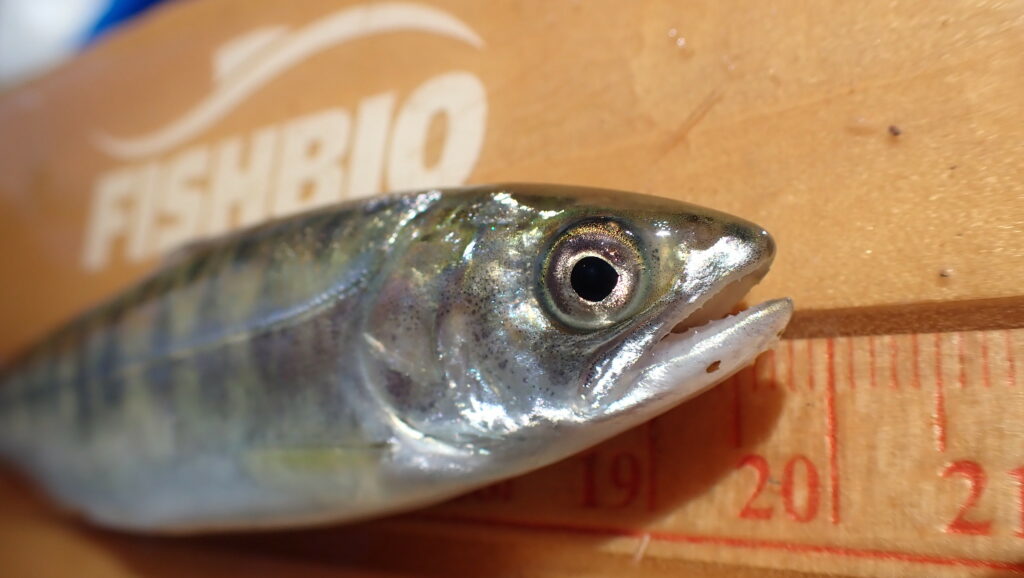Monday September 19, 2022

Chinook salmon (Oncorhynchus tshawytscha) that inhabit the rivers of California’s Central Valley reside on the southern edge of the species’ natural range, and as a result, their populations are facing significant challenges from climate change. This is particularly true of the critically endangered winter-run Chinook of the Sacramento River basin, whose populations have been cut off from their ancestral cold-water streams in the mountains of northern California for nearly 80 years. To prioritize and inform efforts to conserve the remaining winter-run Chinook population, scientists must evaluate and quantify how these fish use habitat across the abridged riverscape of today. In an effort to learn more about movement behaviors and habitats used by winter-run smolts, a team of researchers conducted a five-year study of winter-run migration. Their recent publication (Hassrick et al. 2022) reveals valuable insights into the relationship between flow and winter-run smolt survival, as well as the significance and function of stopover habitats, areas where smolts can rest and feed on their journey.
One vital consideration for the survival of migratory species from ducks to salmon is the extent and quality of stopover habitat. Just as vacationers wouldn’t make it very far into a road trip without gas stations, migrating salmon are less likely to reach their destination if they don’t have places where they can rest and refuel. Understanding where these areas are and how they function is highly valuable, as they could potentially be particularly effective targets for restoration efforts. In addition to evaluating the importance of stopover habitat for winter-run Chinook smolts, the study also investigated effects of flow on survival. Modification of river flows is something managers can directly control through dam releases, and therefore understanding winter-run survival and movement in relation to flow is critical for informing effective management. To learn about these two factors and their relationship to winter-run smolt survival, the researchers conducted a five-year acoustic telemetry study, in which hatchery-reared smolts were implanted with acoustic tags and tracked as they moved downstream through the Sacramento River.

The study focused on movement of smolts from Keswick Dam 387 kilometers (240 miles) downstream to the city of Sacramento. Winter-run smolts were tagged and released over a period that included four years of drought (2013-2016) and one exceptionally wet year (2017). Using an array of receivers operated by the California Fish Tracking Consortium, the researchers collected data on the movement and survival of the tagged smolts, which they then incorporated into statistical models to evaluate the impacts of environmental variables on smolt survival. The study area was divided into multiple reaches, and the environmental factors measured at each reach included temperature, river depth, flow, river velocity, river area shaded by vegetation, and riverbank stability, among others. They also measured smolt travel time per reach to assess the influence of smolt movement rate on survival, as well as how this speed varied across different habitats and flows.
Their findings showed that the time it took the smolts to travel downstream varied by reach and year. Notably, fish slowed their movement early on in their migration and spent time in the upper and middle reaches of the Sacramento River during the high flow year (2017). In contrast, fish only slowed down their migration once they arrived in the lower reaches of the river during the most critically dry year of the study (2013). Further, the stretch that possessed the greatest amount of connected off-channel habitat during the wet year was also the area where smolts most consistently slowed their travel and spent more time. In regard to environmental factors assessed in this study, annual flow variations had the strongest impact on smolt survival. In addition, shaded riverbank and the quality and stability of the river bank also had a positive relationship with smolt survival. Their data also showed that the variation in daily reach-specific river flows had a greater effect on survival in years when annual flow was low compared to years when it was high. This suggests that brief periods of high flow, also known as “pulse flows,” may be important for facilitating smolt outmigration.

The findings of this study provide an improved understanding of winter-run survival during out-migration. Importantly, very little stopover behavior occurred until the smolts reached the furthest downstream reaches of the river during the year with the lowest flows. This may indicate that fish will not continue their downstream migration unless they receive a cue in the form of a pulse in flow. Therefore, maintaining functional flows with well-timed pulses may significantly improve survival even in dry years. However, using pulse flows will become more challenging in the face of more intense droughts, and salmon resilience may become increasingly reliant on restoration of stopover habitats. Results from this study suggest efforts to reconnect off-channel habitat and expand areas of vegetated, shaded riverbank could be effective conservation strategies for winter-run Chinook. As climate change drives more frequent droughts, identifying the key factors that affect smolt survival and drive the timing of outmigration will be of increasing importance, especially as demand for freshwater continues to put more pressure on Chinook and other native fish.
This post was featured in our weekly e-newsletter, the Fish Report. You can subscribe to the Fish Report here.
